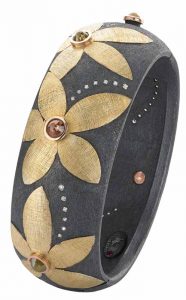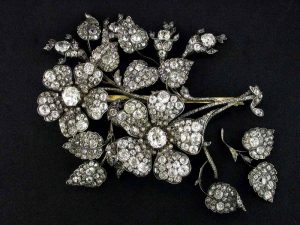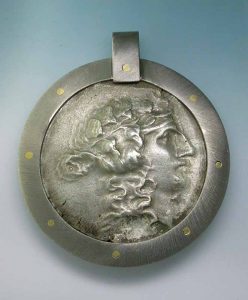By Llyn Strelau

Too often overlooked, silver enjoys a long history and many possible applications. Its use in jewellery, coinage, and objects has been referenced in historical records going back at least 8000 to 10,000 years. Next to gold, it is the most important of the precious metals.
Looking back
Early civilizations initially worked with rare alluvial silver nuggets, as well as the naturally occurring alloy called electrum (which also had traces of copper and other metals). Silver mining followed as the ancients discovered how to separate pure silver from the other metals in these alloys. It is still possible to find cabochons cut from black or white quartz with veins of native silver running through the stone. They make attractive jewellery, especially for the men’s market.
Silver coinage is probably the earliest use of the metal. It is interesting to note in the Roman Empire, there was massive inflation, and the government gutted the silver content of its coinage from more than 95 per cent to 40 per cent and even less by the empire’s end. However, silver coinage is still popular today, albeit more often for collector’s coins than currency due to the lower cost and higher durability of other nonprecious alloys.
Exploring alloys
Pure silver is one of the whitest metals. It is strong, malleable (i.e. able to be rolled or beaten into very thin sheets without fracture), and ductile (i.e. able to be formed by elongation without cracking).
Pure silver is, for most purposes, too soft to craft durable articles. Therefore, various alloys are used instead. The most common is sterling silver (92.5 parts pure silver, usually with copper making up the balance). This creates a stronger alloy while still retaining good workability.

Photos courtesy Llyn L. Strelau
The one downside of alloying copper and silver is oxidation. Copper reacts with sulphur in the environment to form sulphur oxides, which appear grey to black on the surface as tarnish develops. However, this surface tarnish is easily dealt with, either by polishing on a buff or using one of the wide range of available silver polishing products.
A greater problem is during production of sterling silver items, the metal is heated, and fire scale—a tough layer of copper oxides—is brought to the surface. If not removed, this will remain as a stain on the otherwise bright, polished surface. There are various coatings that can be applied prior to heating to reduce fire scale. Any that remains must be removed using abrasives and polishing compounds.
Fortunately, in recent years, new proprietary alloys have been developed. Some are very resistant to the bane of fire scale and much less prone to tarnishing in the future. They are complex blends of silver with small amounts of copper, tin, germanium, chromium, tantalum, titanium, gold, or platinum group metals added, among others. For the most part, these alloys can be worked with traditional methods, but some do require special protocols for annealing and soldering to maintain their properties. If you use them, be sure to check with your supplier for specific instructions on how to best work with them to avoid problems.

I used one of these alloys to make the spaceship ornament pictured later in this article. After casting, the metal was rather soft, and it was tricky to retain the accuracy the project required. However, the tarnish resistance the alloy provided once the piece was finished was a bonus, and once we figured out its specific qualities, fabrication was successful.
The alloy required a lower annealing temperature compared to standard sterling and also retained heat longer. Initially, we had issues with the larger sections warping, and this could have been avoided by being more careful with heating and cooling. Soldering proved to be more similar to working with gold, because the heat from a torch did not dissipate as quickly as with copper-based alloys. It was also more fragile when at soldering temperature, so we had to be careful not to move it or touch it with tweezers until it had cooled slightly.
It’s important to check the web for information on whichever new alloy you are using. The manufacturers and suppliers have very good resources that can save you a lot of grief.





